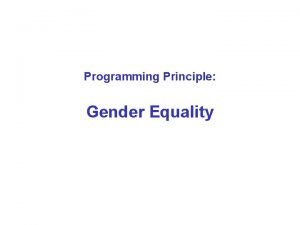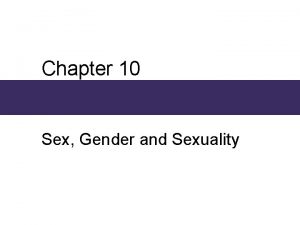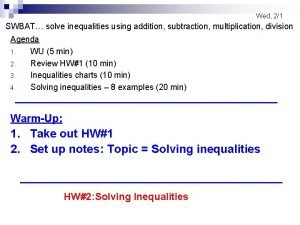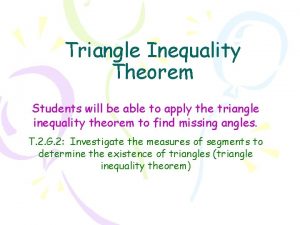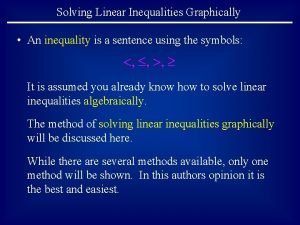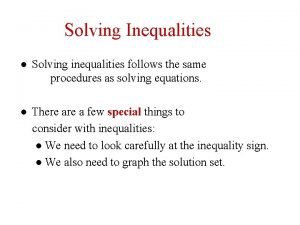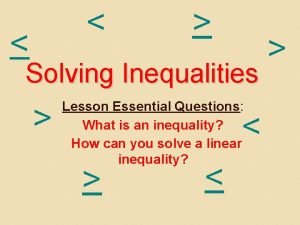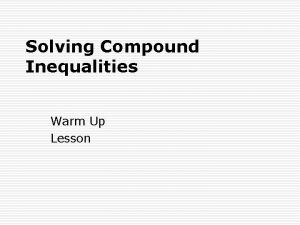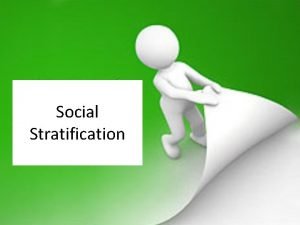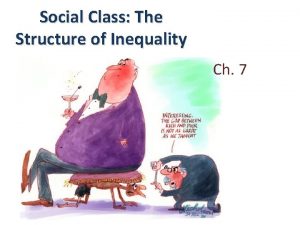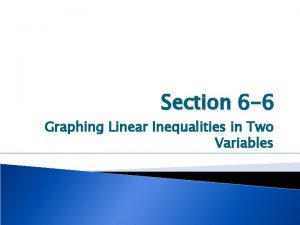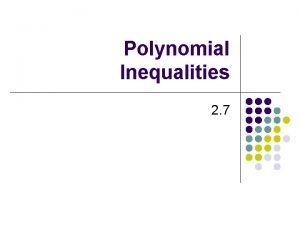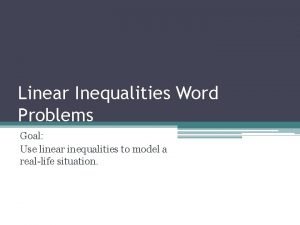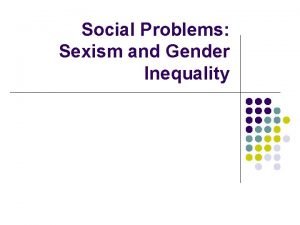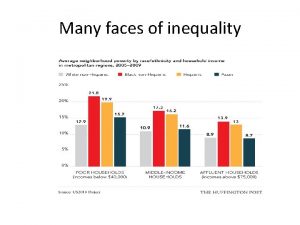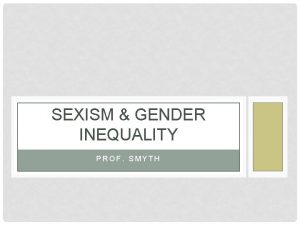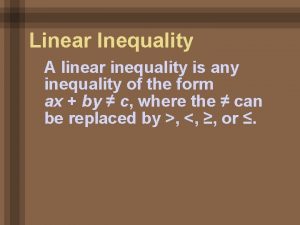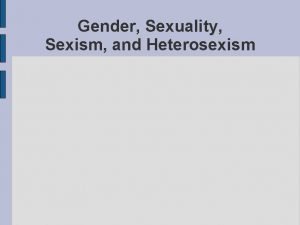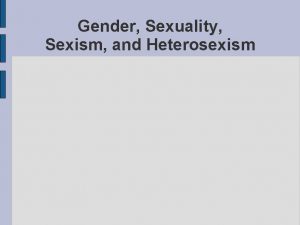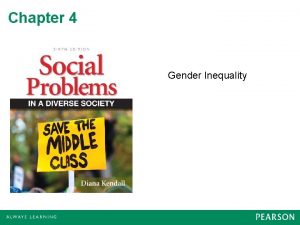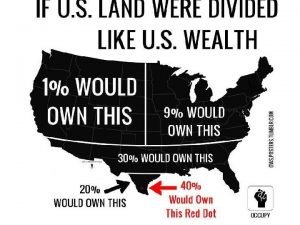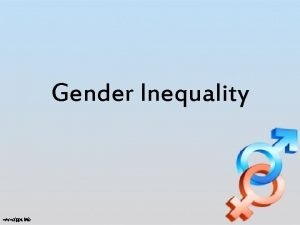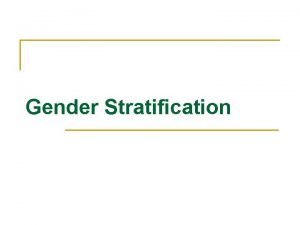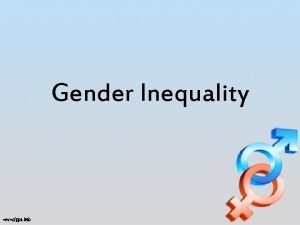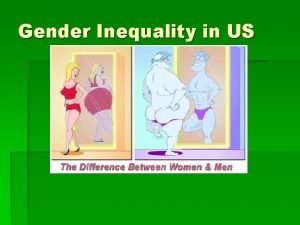Chapter 4 Gender Inequality What is Gender Gender
































- Slides: 32

Chapter 4 Gender Inequality

What is Gender? ¡ Gender: the personal traits and life chances that a society links to being female or male ¡ Sex: the biological distinction between females and males

Gender Stratification and Patriarchy ¡ Gender is an important dimension of social inequality. l Gender stratification frequently takes the form of patriarchy (social patterns by which males dominate females) l Patriarchy is widely evident in the U. S. and around the world l Sociologists see patriarchy - and the entire range of gender - as the creation of society itself l Matriarchy is a social pattern in which females dominate males

Gender Stratification and Patriarchy l Explanations of Patriarchy ¡ Men’s greater body size and strength ¡ Brain power ¡ Greater aggressiveness (testosterone) ¡ Most sociologists reject the idea that any behavior is “hard-wired” into human biology

The Problem of Sexism ¡ Sexism is the assertion that one sex is innately inferior to the other ¡ Sexism supports patriarchy by claiming that men are “better” than women and therefore should dominate them.

Gender and the Family ¡ ¡ ¡ The importance of gender to family life begins with the fact that most expectant parents prefer a son to a daughter. The influence continues in the childhood socialization process. After reaching adulthood, gender makes marriage two distinctive relationships l Jessie Bernard’s “his” marriage and “her” marriage (Life gets better, but for whom? )

Gender and Education ¡ Even before starting school, children are exposed to gender bias in children’s books. ¡ 56% of college students are women l social pressures still steer women toward majors in English, dance, drama, or sociology l men still are directed toward physics, economics, biology, mathematics and computer science

Gender and Education ¡ ¡ Title IX- banned sex discrimination in any educational program receiving federal funding. Despite the passage of Title IX in 1972, equality in athletic programs is more the exception than the rule

Gender and the Mass Media ¡ ¡ ¡ There are more than 250 million televisions in the US. TV directs its advertising toward women but ignores them in TV programming. Women often have supporting roles that reinforce traditional gender roles.

Gender and Religion ¡ ¡ ¡ Religion has traditionally been patriarchal In recent decades, more liberal denominations have moved toward greater gender equality l This liberal trend includes revising prayers, hymnals, and even the Bible to reduce sexist language, as well as ordaining both men and women as priests Orthodox Judaism, Islam, and Roman Catholicism have retained traditional male leadership

Gender and Politics ¡ ¡ ¡ Women have played only a marginal role in this nation’s political history Thousands of women now serve at the local levels as mayors and council members In 2006, 23 percent of the state legislators were women and 8 of the 50 state governors were women.

Gender and the Military Women have been part of the military since the Revolutionary War ¡ During World War II, when the government officially opened the military to both sexes, women made up just 2 percent of the armed forces ¡ Women are 15 percent of the U. S. military fighting force in Iraq ¡

Gender and Work ¡ ¡ ¡ By 2005, three in five women are in the work force Sixty two percent of married women with children under the age of six work Eighty percent of women with children ages six to seventeen work

Gender and Work ¡ ¡ ¡ Even though more women work for pay, their range of jobs is still limited Gender discrimination was outlawed by the Federal Equal Pay Act of 1963 and Title VII of the Civil Rights Act of 1964, but even today it continues to be an issue The glass ceiling addresses subtle discrimination in the top positions

Gender Stratification ¡ ¡ Inequality between men and women is reflected in differences in income and in responsibility for housework, as well as in patterns of violence and even reproductive issues Gender income inequality is the result of men holding different kinds of jobs, family life, and gender discrimination

Violence Against Women ¡ ¡ ¡ Perhaps the most serious problem linked to patriarchy is men’s physical violence against women l Assault, rape, and murder are common Why is violence a gender issue? l Physical aggressiveness is a key element of the cultural definition of masculinity. l Gender violence is not so much sexual as an expressions of power When it comes to serious violence, the most dangerous setting for women is the home

Sexual Harassment ¡ Sexual Harassment: unwanted comments, gestures or physical contact of a sexual nature l Quid Pro Quo- sexual harassment that is blatant and direct is a violation of civil rights l Hostile Environment- more subtle behavior

Sexuality, Beauty and Reproduction ¡ ¡ ¡ Beauty is about power and inequality Social norms encourage females to wear attractive clothes and to be attentive to men Women’s reproduction has been regulated l regulation of birth control l restricted access to abortion clinics

Women: A Majority-Minority ¡ ¡ Numerically, women are a slight majority of the U. S. population Women meet the test of being both a physically distinctive and disadvantaged category l Women have less income, wealth, and power than men

Minority Women: Intersection Theory ¡ Minority women are doubly disadvantaged l They earn less than white women l Minority women earn less than minority men l In 2002, African American women earned 63 percent as much as white men and Hispanic women earned 51 percent as much as white men.

Structural-Functional Analysis: Gender and Complimentarity ¡ Functionalists contend that differences between men and women help build families and integrate society as a whole (instrumental and expressive roles) ¡ The structural-functional analysis of gender was quite influential fifty years ago but is far less today

Structural-Functional Analysis: Gender and Complementarity ¡ Critics contend that: l functionalism ignores how men and women can and do relate to one another in a variety of ways that do not fit any norm l functionalism fails to take into account the personal strains and social conflicts produced by rigid gender patterns

Symbolic-Interaction Analysis: Gender in Everyday Life ¡ The symbolic-interaction paradigm provides a micro-level analysis of gender at work in the everyday lives of individual people l l l ¡ Personal behavior Use of space Language Gender directly affects personal behavior, the use of space, and the language we use

Symbolic-Interaction Analysis: Gender in Everyday Life ¡ Critics point out that symbolic-interaction overlooks the fact that gender is a basic part of social organization

Social-Conflict Analysis: Gender and Inequality ¡ Friedrich Engels expanded Marx’s theory to include gender, arguing that the same process that allows a ruling class to dominate a worker places men in a dominant position over women l Patriarchy is a system by which wealthy men transmit their wealth to their sons. l The double problem of capitalism lies in exploiting men in the factories and exploiting women in the home

Social-Conflict Analysis: Gender and Inequality ¡ Critics of this perspective point out: l Families perform vital task of raising children l Not everyone defines the differences as unjust l Patriarchy also occurs in socialist nations such as Cuba and The People’s Republic of China

Feminism ¡ Feminism: l the study of gender with the goal of changing society to make women and men equal l involves both theory and action

Feminist Foundations ¡ There is no one version of feminism, but almost all feminists agree on: l the importance of gender; l the importance of change; l the importance of choice; l the need to eliminate patriarchy; l the need to eliminate violence against women; and l the importance of sexual autonomy

Types of Feminism ¡ Types of feminists: l Liberal feminists - want women and men to be treated as individuals but want change to occur within existing social institutions l Socialist feminists -claim that a Marxiststyle class revolution is needed to secure equality for all people l Radical feminists -argue that patriarchy is built into the concept of gender itself and nothing short of erasing gender will bring about equality

Politics and Gender: Constructing Problems and Defining Solutions ¡ Conservatives focus on the value of families l While most conservatives are willing to support women in the workplace and even in positions of national leadership, most also support policies to strengthen families l Believe that gender equality may weaken the family

Politics and Gender: Constructing Problems and Defining Solutions ¡ Liberals focus on the pursuit of equality and speak out in favor of the slow but steady progress that has been made to expand the rights and opportunities for l l l Families have changed because families need two working adults to make ends meet Men must take greater responsibility for the home and children The earning power of women must be raised

Politics and Gender: Constructing Problems and Defining Solutions ¡ Radicals argue that, at a minimum, basic change must come to the economic and political system l The target of basic change is the family l Some radical feminists promote the elimination of gender itself
 Lesson 1-6 solving compound and absolute value inequalities
Lesson 1-6 solving compound and absolute value inequalities Conclusion of gender
Conclusion of gender Methodology of gender inequality
Methodology of gender inequality Gender inequality in politics
Gender inequality in politics Gender inequality case study
Gender inequality case study Are gender roles a social construct
Are gender roles a social construct Short poem on gender equality
Short poem on gender equality Strategic gender needs and practical gender needs
Strategic gender needs and practical gender needs Chapter 10 sex gender and sexuality
Chapter 10 sex gender and sexuality Chapter 11 gender age and health review worksheet answers
Chapter 11 gender age and health review worksheet answers Triangle inequality subtraction
Triangle inequality subtraction Quadrilateral inequality theorem
Quadrilateral inequality theorem Pythagorean inequality theorem
Pythagorean inequality theorem Exterior angle inequality theorem
Exterior angle inequality theorem Traveling salesman problem
Traveling salesman problem Packet 22 inequality word problems
Packet 22 inequality word problems Representing inequalities graphically
Representing inequalities graphically Linear inequalities symbols
Linear inequalities symbols Inequality examples math
Inequality examples math Open inequality
Open inequality Multiplication property of inequality
Multiplication property of inequality How to solve a compound inequality
How to solve a compound inequality Social stratification in sociology
Social stratification in sociology Class inequality
Class inequality What inequality utilize left-tailed test
What inequality utilize left-tailed test 6-6 practice systems of linear inequalities
6-6 practice systems of linear inequalities Proof of chebyshev's inequality
Proof of chebyshev's inequality Polynomial inequality definition
Polynomial inequality definition How to graph an inequality
How to graph an inequality Proof of am gm inequality
Proof of am gm inequality Division property of inequality example
Division property of inequality example Logarithmic inequality definition
Logarithmic inequality definition How to solve linear inequalities word problems
How to solve linear inequalities word problems


